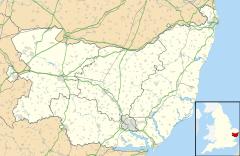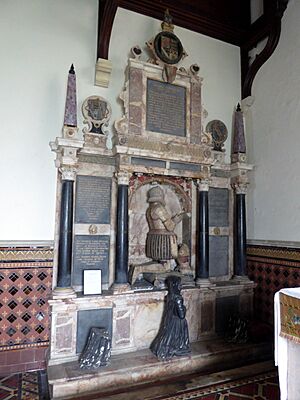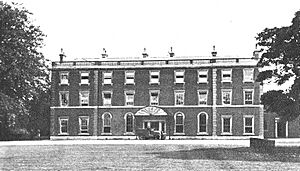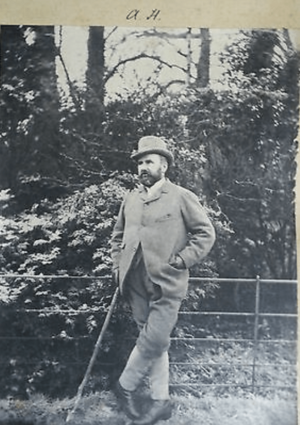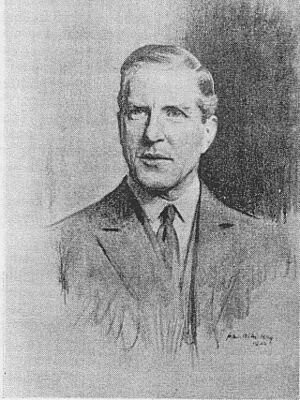Sudbourne facts for kids
Quick facts for kids Sudbourne |
|
|---|---|
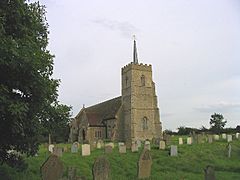 All Saints' Church, Sudbourne |
|
| Population | 309 (2011) |
| District |
|
| Shire county | |
| Region | |
| Country | England |
| Sovereign state | United Kingdom |
| Post town | Woodbridge |
| Postcode district | IP12 |
| EU Parliament | East of England |
| UK Parliament |
|
Sudbourne is a small village and civil parish in Suffolk, England. It is located about 2 miles (3.2 km) north of Orford.
The village is home to All Saints' Church, which was built in the 14th century. It was later repaired and updated in 1879. This church is considered a Grade II* listed building, meaning it is very important historically.
Long ago, between 964 and 975, King Edgar and his wife Ælfthryth gave land in Sudbourne to Bishop Æthelwold of Winchester. They did this on one condition: he had to translate an important Latin book, the Rule of Saint Benedict, into Old English.
Some historians believe that Sudbourne was the site of a battle called the Battle of Newmouth. This fight between the English and the Danes happened in the early 11th century.
During World War II, Sudbourne and the nearby village of Iken were used for battle training. Soldiers practiced here for the D-Day landings in June 1944. The people living in the villages had to move away and returned after the war ended.
Sudbourne also has some special natural areas. Captain's Wood is a nature reserve managed by the Suffolk Wildlife Trust. Crag Farm Pit is another important natural site. It is listed as a Site of Special Scientific Interest in Suffolk. Sudbourne is also the birthplace of Sir Thomas Rush.
Contents
- Discovering Sudbourne Hall's History
- The Stanhope Family at Sudbourne
- The Devereux Family Takes Over
- The Seymour-Conway Family and a New Hall
- Sir Richard Wallace and His Art Collection
- The Heywood Family's Time
- The Clark Family and Major Changes
- The Boynton Family and Timber
- The Watson Family and Sporting Life
- The Lyon Family's Ownership
- The Greenwell Family and Wartime Use
- Images for kids
Discovering Sudbourne Hall's History
Sudbourne Hall was a large and important estate in Sudbourne. Over the centuries, it was owned by several different families. Each family added their own story to the hall's long history.
The Stanhope Family at Sudbourne
Sir Michael Stanhope (1549-1621) bought the Sudbourne estate from the Crown. He was a Member of Parliament (MP) and worked for Queen Elizabeth I. The manor house, then called "Chapmans," later became Sudbourne Hall.
Sir Michael made many improvements to the estate. He built a sea wall almost a mile long to protect the land. He also drained the wet coastal areas, which made the air much healthier. These changes greatly increased the estate's value.
He married Anne Read, and they had four daughters. One daughter, Jane Stanhope, inherited Sudbourne. She married Sir William Withypoole. You can still see Sir Michael Stanhope's monument in Sudbourne Church today.
The Devereux Family Takes Over
The Sudbourne estate later passed to the Devereux family. This happened when Leicester Devereux, 6th Viscount Hereford (1617–1676) married Elizabeth Withypoole. Elizabeth was the daughter of Jane Stanhope, who had inherited Sudbourne.
The Devereux family owned Sudbourne for many years. You can find special funeral plaques, called hatchments, for some members of the Devereux family in All Saints' Church.
The Seymour-Conway Family and a New Hall
In 1753, the Sudbourne estate was sold to Francis Seymour-Conway, 1st Marquess of Hertford (1718–1794). In 1784, he hired the famous architect James Wyatt to rebuild Sudbourne Hall. The new hall was located about a mile southwest of the church.
Under the Seymour-Conway family, the estate grew very large. By 1840, it covered about 12,000 acres. This included almost all of the villages and parishes of Orford, Sudbourne, Butley, Chillesford, Gedgrave, and Iken.
The family mainly lived in Paris or at their other large home, Ragley Hall in Warwickshire. Sudbourne Hall was often used as a place for hunting and sports.
Sir Richard Wallace and His Art Collection
When the 4th Marquess of Hertford died in 1870, his son, Sir Richard Wallace, 1st Baronet (1818-1890), inherited his father's amazing art collection. However, he did not inherit the Sudbourne estate itself.
In 1872, Sir Richard Wallace bought Sudbourne from the new Marquess for a large sum of money. After a war in Paris, he moved his father's art collection to London for safety. This collection is now known as the Wallace Collection and is open to the public.
Sir Richard was a great sportsman. He turned Sudbourne into a famous shooting estate. Even the Prince of Wales visited to hunt there in 1879. He had many gamekeepers and servants to help with his hunting guests. He even had paintings made of his shooting parties, which are now in Orford Town Hall.
Sir Richard also paid to restore Sudbourne Church in 1878-79. In 1884, he sold the Sudbourne Estate to Arthur Heywood.
The Heywood Family's Time
Arthur Heywood (1834-1920) was a banker. He bought Sudbourne Hall in 1884. He was born in Essex and had lived in Lancashire.
Arthur Heywood started the Sudbourne Cricket Club. In 1891, he held the important local role of High Sheriff of Suffolk. In 1897, he sold Sudbourne to Arthur Herbert Edward Wood. He then bought another large hunting estate nearby, Glevering Hall, where he lived until he died in 1920.
The Clark Family and Major Changes
In 1904, Arthur Wood sold Sudbourne to Kenneth Mackenzie Clark (1868–1932). Kenneth Clark was a very rich Scottish businessman. His family made their money from cotton thread manufacturing. Their company, Clark & Co Ltd, was famous for being the first to sell thread on wooden spools.
Kenneth Clark bought Sudbourne mainly for the hunting. He wanted his guests to have the best pheasant shooting experience in Suffolk.
His son, Kenneth Clark, 1st Baron Clark (1903-1983), who became a famous art historian, grew up at Sudbourne Hall. He later wrote about the hall in his autobiography. He described the hall as a "large, square, brick box." His parents hired an architect to make it more comfortable, and the inside was changed to a "pseudo-Jacobean style" with lots of carved wood.
Lord Clark also described the beautiful park around the hall. It had four long avenues of trees, a nine-hole golf course, and circles of beech trees where their Suffolk Punch horses were kept.
The Clark family sold the Sudbourne estate in May 1918.
The Boynton Family and Timber
In 1918, most of the Sudbourne estate was sold by Kenneth Clark to Walter Boynton. Lord Clark called Boynton a "speculator." This means he was mainly interested in making money from the estate's timber. He cut down many of the trees.
The Clark family stayed at the hall for two more years until the sale was complete. Although Boynton sold most of the estate again in 1920, he still owned a lot of land in the Iken area in 1929.
The Watson Family and Sporting Life
The next owner in 1920 was Joseph Watson, 1st Baron Manton (1873-1922). He was a wealthy manufacturer of soap and munitions from Yorkshire. He had retired from business to focus on sports and farming.
He bought five large country estates around the same time, totaling about 20,000 acres. Sudbourne was about 9,000 acres of this. Sadly, he died in a fox-hunting accident only four years later, in 1922. After his death, 7,650 acres of the Sudbourne estate, including Sudbourne Hall, were sold. This sale marked the complete breaking up of the large estate.
However, one of Watson's sons, Alastair Joseph Watson (1901–1955), inherited about 1,200 acres of Sudbourne. This part was centered around Chillesford Lodge. This lodge was a special farm built by Sir Richard Wallace in 1875-76.
Alastair Watson continued to keep the famous "Sudbourne" herds of Red Poll cattle and the "Sudbourne" stud of Suffolk Punch heavy horses. These animals won many prizes.
In the 1930s, parts of the former Sudbourne estate became part of the Forestry Commission. This included Chillesford Wood and Sudbourne Wood. These areas are now part of Tunstall Forest.
Alastair Watson also built the Chillesford Polo Ground in 1936. It was a private club for family and friends. It was known for its advanced irrigation system, which was unique in England at the time. The club closed during World War II but reopened in 1948.
Today, the Chillesford Lodge estate is still owned by George Watson, a grandson of Alastair Watson. He has turned the old farm buildings into homes.
The Lyon Family's Ownership
After Lord Manton's death in 1922, Sudbourne Hall and some land were bought by Malcolm Lyon. He was a company director.
By 1929, Lyon had increased his land at Sudbourne to 510 acres. This included the Hall, parkland, and four cottages. However, in 1935, he was declared bankrupt.
The Greenwell Family and Wartime Use
Sudbourne Hall and the rest of the estate were bought in the 1930s by Sir Bernard Eyre Greenwell, 2nd Baronet (1874-1939). He was a senior partner in a well-known stock-broking firm. He also bought other nearby estates, including Gedgrave Hall and Butley Abbey.
During World War II, Sir Bernard's son, Sir Peter McClintock Greenwell, 3rd Baronet (1914–1978), was captured at the Battle of Dunkirk. While he was a prisoner of war, the Sudbourne estate was managed by an agent.
In 1942, a large area around Sudbourne, including Orford and Iken, was taken over by the War Department. It became the "Orford Battle Training Area." People had to leave their homes so the army could use the land for tank training. Sudbourne Hall became the headquarters for officers.
This training area was used by the 79th Armoured Division. This special army unit developed new machines and methods to break through enemy defenses for the D-Day landings. These special vehicles were known as "Hobart’s Funnies."
After the war, in 1948, the War Department released the area. Sudbourne Hall was in very bad condition. In 1953, the 3rd Baronet had it demolished, and the beautiful Italian gardens were left to nature.
In 2014, the Sudbourne estate, which was then 530 acres, was owned by Sir Edward Bernard Greenwell, 4th Baronet (born 1948). He also owns nearby Gedgrave Hall and Butley Abbey. In 2014, he planned to build houses within the old walled garden at Sudbourne. The money from these houses would be used to plant new trees, restore driveways, and fix the historic walled garden.
Images for kids


